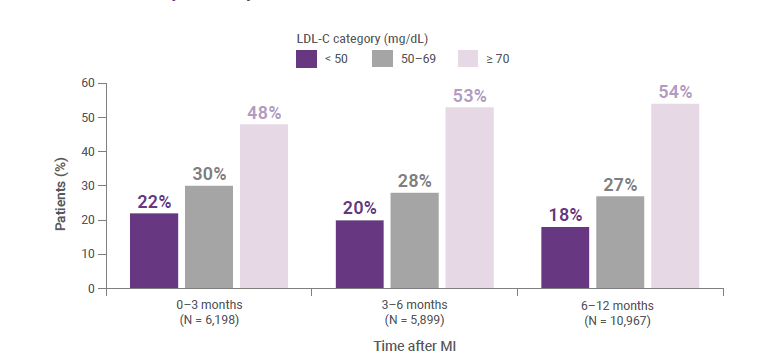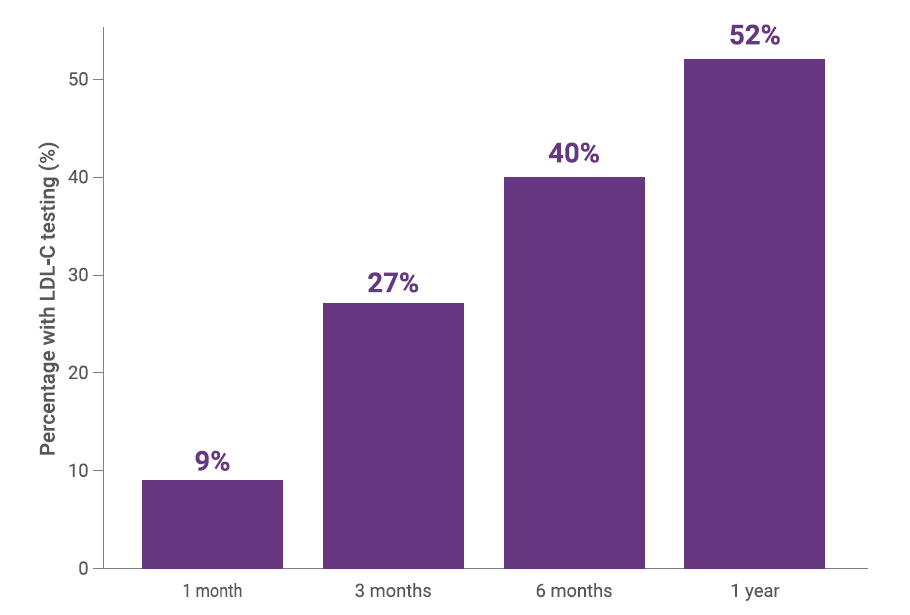Many ASCVD Patients Do Not Achieve Recommended LDL-C Levels, Where Additional Therapy Is Indicated1
Numerous clinical and epidemiological studies have consistently shown that the majority of ASCVD patients at high risk for cardiovascular (CV) events do not achieve the recommended low-density lipoprotein cholesterol (LDL-C) levels. Most patients with established cardiovascular disease (CVD) remain above recommended LDL-C thresholds.1,2
In the Recent Prospective Observational GOULD Registry Involving > 5,000 Patients With ASCVD Receiving Lipid-lowering Therapies:1




In a Retrospective Cohort Study, Only Half of Medicare Patients With Recent MI Had LDL-C Levels < 70 mg/dL During the Year Following Their MI2
Despite the increased risk of another CV event during the first year after myocardial infarction (MI), the percentage of patients with LDL-C < 70 mg/dL steadily decreased from 52% within 3 months, to 48% within 3 to 6 months, and to 45% within 6 to 12 months.
LDL-C Distribution by Recency of MI

Retrospective cohort study using the Medicare fee-for-service claims linked to the Prognos LDL-C database. US population only.
Patients were included if they had an LDL-C value (index) in calendar year 2017 and a primary diagnosis of MI associated with hospitalization in the year before the index. LDL-C, low-density lipoprotein cholesterol; MI, myocardial infarction.
LDL-C Testing Rates in Patients After MI Hospitalization Remained Suboptimal3
Only a third of patients received any LDL-C testing within 3 months after MI, and only half of patients received LDL-C testing in the year following MI hospitalization.
In a Retrospective Study, LDL-C Testing Rates Following Post-MI Hospitalization

Retrospective study using claims data from a large US population (n = 389,367) with Medicare supplemental or commercial insurance. Patients were included if their first MI hospitalization occurred during January 1, 2008 to March 31, 2019, with 1 year of continuous enrollment in insurance leading up to the hospitalization. LDL-C testing was assessed in the year before admission and for up to 1 year after discharge, with censoring due to insurance plan dis-enrollment.
LDL-C, low-density lipoprotein C; MI, myocardial infarction.
- Cannon CP, de Lemos JA, Rosenson RS, et al. Use of lipid-lowering therapies over 2 years in GOULD, a registry of patients with atherosclerotic cardiovascular disease in the US. JAMA Cardiol. 2021;6(9):1060-1068. doi:10.1001/jamacardio.2021.1810.
- Desai NR, DiMario S, Schludi B, et al. LDL-C values and lipid lowering therapy utilization among medicare beneficiaries with a recent myocardial Infarction. Circulation. 2019;140:A13945. doi:10.1161/circ.140.suppl_1.13945.
- Levintow SN, Reading SR, Noshad S, et al. Lipid testing trends before and after hospitalization for myocardial infarction among adults in the US, 2008-2019. Eur Heart J. 2021;42:supp 1. doi:10.1093/eurheartj/ehab724.2941.
